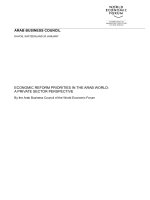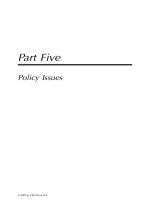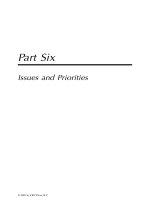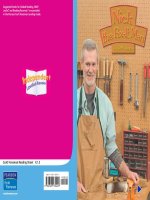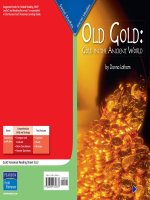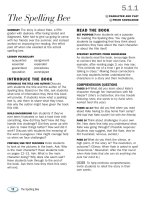- Trang chủ >>
- Mầm non - Tiểu học >>
- Lớp 5
5 6 3 old gold gold in the ancient world TG
Bạn đang xem bản rút gọn của tài liệu. Xem và tải ngay bản đầy đủ của tài liệu tại đây (119.27 KB, 4 trang )
Flying Across the Ocean:
Yesterday and Today
SUMMARY
This reader gives a history of
transatlantic flight, beginning with the 1919
crossing by a military plane. From there, the
era of zeppelins and Lindbergh’s famous flight
to Paris were not far behind.
LESSON VOCABULARY
criticizing
drenching
explosion
cruised
era
hydrogen
INTRODUCE THE BOOK
INTRODUCE THE TITLE AND AUTHOR
Discuss with
students the title and author of Flying Across
the Ocean: Yesterday and Today. Discuss
what they can predict about the article based
on the title and the social studies content
triangle. Ask: “How would your expectations
differ if the content triangle read science?
What images does the title give you?”
BUILD BACKGROUND
Discuss what students
know about airplane travel, including travel
in small planes, or the history of flight.
Ask: “What is the longest flight you have
taken?” If any of them have visited museums
documenting flight, ask them to share what
they remember. Ask what images the names
Lindbergh, Hindenburg, and Wright brothers
bring to mind. If possible, show images from
books or from the Internet that document
events in the early days of flight.
PREVIEW/USE TEXT FEATURES
Have students
take a few minutes to go over the photos,
captions, and diagrams. Ask them to discuss
what these tell them about the selection.
Ask: “What do the photos add? Do they relay
facts, give context, create mood? Would you
understand the information as well without
them?” Point out that the graphics follow a
chronological order. What does this suggest
about the article’s content and structure?
124
5.6.4
FACT AND OPINION
ASK QUESTIONS
READ THE BOOK
SET PURPOSE
Guide students to set their own
purposes for reading the selection. Students’
interest in airplanes or the history of flight
should guide this purpose. Invite them to
come up with questions they would like to
have answered, such as: Why did Alcock and
Brown get a prize? What did Lindbergh feel
like as he flew alone in that small plane?
STRATEGY SUPPORT: ASK QUESTIONS
Remind
students that asking questions as they read
will help them focus their attention on the
subject matter and better understand the
text. Before students read each section of
the book, have them write down at least one
question they have, based on headings and
pictures. If they do not find the answer by
reading the text, have them research to find
the answer.
COMPREHENSION QUESTIONS
PAGE 3 Identify one statement of opinion on
this page. (Today we think nothing of crossing
the Atlantic Ocean in just a few hours.)
PAGE 13
Is the sentence “Both men climbed
out, unhurt” a statement of fact or of opinion?
(The sentence is a statement of fact.)
PAGE 22
Look at the last sentence on the
page. Rewrite this sentence using a synonym
for drenching. (Possible response: Over
Canada, rain was completely soaking the
plane.)
PAGE 23
What does the fact that Lindbergh
couldn’t sleep the night before take-off add to
this account? (Possible response: It helps you
understand that he was probably anxious.)
Flying Across the Ocean: Yesterday and Today
16911_LRD_TG_124-125 124
12/16/05 9:33:31 AM
REVISIT THE BOOK
READER RESPONSE
1. Possible response: Opinions—Today we
think nothing of crossing the Atlantic Ocean
in just a few hours; Lindbergh believed that
this was his chance. Facts—In 1913, the
race to cross the Atlantic by airplane began;
their trip took 16 hours and 27 minutes.
2. Responses will vary.
3. Possible response: across the Atlantic;
Sentences will vary.
4. Possible response: Modern jets are much
safer and faster, they can stay in the air
longer, pilots use technology to stay in
touch with the ground, see where they are
going, and de-ice the wings
EXTEND UNDERSTANDING
Invite students to
create their own graphic device, such as a
time line or a fact-and-opinion chart that
relates information from the article. Ask:
“What visual tool helps you best understand
this material? If you were the author, what
additional graphics would you have included?
What photos would you be interested in
seeing, for example?” Remind students that
maps and other graphics convey information
that is not necessarily in the text.
RESPONSE OPTIONS
WRITING
Ask students to imagine that each
is the pilot on a pioneering solo flight many
years ago, such as Lindbergh’s flight to
Paris. Have them write a journal entry or
logbook entry describing an hour of their
flight. Encourage them to include weather
information and descriptions of their
thoughts and feelings.
SOCIAL STUDIES
CONNECTION
Ask students to pick a
famous plane or airship,
such as the Hindenburg, and
research how it was built, including
who financed it, and what innovations it used.
Invite them to share their research with other
students.
Skill Work
TEACH/REVIEW VOCABULARY
Divide students into two groups. Ask one
group to write fill-in-the-blank sentences for
the vocabulary words. Then ask students in
the other group to fill in the correct word.
Ask the groups to switch roles and repeat
the exercise.
To reinforce meaning, have students
sort the words by parts of speech. Point out
that words with the same suffix, such as
-ing, are not always the same part of speech.
TARGET SKILL AND STRATEGY
FACT AND OPINION Tell students that a
statement of fact can be proved true or
false, while a statement of opinion is a
statement of someone’s judgment, belief,
or way of thinking about something. Guide
students to identify statements that cannot
be verified by using the first sentence on
page 3 as an example. Ask students to
make a list of statements of opinion and
fact as they read. Challenge them to verify
several of the statements of fact by referring
to books or their own experience.
ASK QUESTIONS
Tell students that asking
questions as they read is a way of being
actively involved in what they are learning,
understanding the information presented,
and distinguishing statements of fact from
statements of opinion. Brainstorm with
students the types of questions they might
have as they read Flying Across the Ocean:
Yesterday and Today, such as: What does
this mean? Why did the writer include this?
Can I verify this statement in an outside
source?
ADDITIONAL SKILL INSTRUCTION
GRAPHIC SOURCES
Ask students to identify all
the graphic sources used in Flying Across the
Ocean: Yesterday and Today. Ask: Do these
graphics help you understand the material
discussed in this article? Do they add new
information not provided in the words?
Flying Across the Ocean: Yesterday and Today
16911_LRD_TG_124-125 125
125
12/16/05 9:33:32 AM
Name
Flying Across the Ocean
Fact and Opinion
• A statement of fact is a statement that can be proved true or false.
• A statement of opinion tells someone’s ideas, feelings, or beliefs. It cannot be proved true or false.
Directions Read the sentences below. On the line under each sentence, write either “statement of fact”
or “statement of opinion.” Give a reason for your response.
1. Today we think nothing of crossing the Atlantic Ocean in just a few hours.
2. In 1913, the race to cross the Atlantic Ocean by airplane began.
3. World War I led to many improvements in airplane technology.
4. The first plane to make the Atlantic Ocean crossing was a military plane.
5. Ice is no longer a major problem for modern aircraft.
6. After the Hindenberg accident, nobody wanted to ride in an airship.
7. Charles Lindbergh is the most famous pilot in history.
Directions Write a statement of fact about Flying Across the Ocean: Yesterday and Today.
Directions Write a statement of opinion about Flying Across the Ocean: Yesterday and Today.
© Pearson Education 5
8.
9.
126
16911_LRD_TG_126-127 1
12/16/05 9:34:51 AM
Flying Across the Ocean
Name
Vocabulary
Directions Choose the word from the box that best matches each definition. Write the
word on the line.
Check the Words You Know
criticizing
era
cruised
explosion
drenching
hydrogen
1.
a period of time marked by certain events, persons, or things
2.
a colorless, odorless, highly flammable gas
3.
the act of bursting forth with sudden violence or noise
from internal energy
4.
wetting thoroughly; soaking with falling liquid, as with rain
5.
finding fault
6.
flew at the most efficient operating speed
© Pearson Education 5
Directions Write a paragraph about early transatlantic flights. Use as many of the vocabulary
words as you can.
127
16911_LRD_TG_126-127 2
12/16/05 9:34:52 AM
